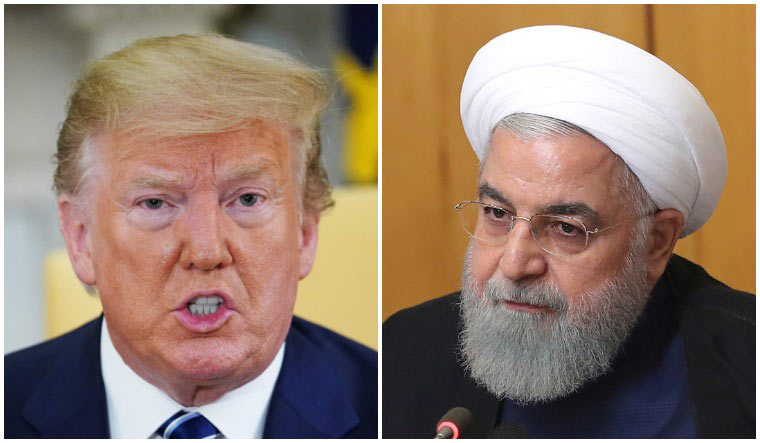In the Middle East, tankers are blazing again, gun boats are dropping mines, warships are out patrolling and surveillance drones are falling out of the sky. As far as history is concerned, this isn't 'uncharted waters', the stakeholders have seen this all in the late 1980s, and lest they forget, that conflict had nightmarish consequences. They didn't just spill a fortune of oil, they spilt a lot of innocent blood, too.
The 'tanker-war' was a feature at the tail-end of the Iran-Iraq conflict in the 1980s. Both parties were out on an oil tanker-attacking spree, with water mines, jets, missiles and all. Eventually, even ships from neutral nations wouldn't be spared, as the rivals sought to cripple their opponent under international displeasure.
The Iranians and the Americans were foes back then too, but the US didn't really intend to join the bloodbath, but just as what happened in World War II, they slipped into it.
ALSO READ: Trump ordered attacks on Iran over downed drone, but pulled back, says report
An American missile frigate patrolling the region called the USS Stark was off the Bahrain coast when it was hit by Iraqi Exocet missiles, killing 37 US navy personnel on board. This came at a time when President Ronald Reagan was unwilling to send his troops into another fight as the then Cold War situation meant a third World War was on the brink. But post this attack, which was eventually conceded to have been an accident by Iraqi officials, the Americans led convoy operations escorting oil tankers through the troubled waters, giving allied countries protection to pass through the conflicted zone. Kuwaiti tankers, the most vulnerable of neutral nations, got their tankers bearing Iraqi oil re-registered with American flags in a bid to thwart any aggression from the Iranians.
But, things were just starting to spiral out of control when one of the re-flagged tankers of the Kuwaitis hit a mine, incidentally on the maiden US-led convoy mission in July 1987. Now, the US had been irked beyond tolerance as the superpower responded with attacks on Iranian vessels that were allegedly planting mines in the strait.
also read
- Iran’s supreme leader opens door to negotiations with US over Tehran’s nuclear program
- 'We support Israel’s right to defend itself': Rishi Sunak's UK to China, how the world reacted to Iran's drone strike
- Iran's aerial attack on Israel: 5 major developments as over 200 drones shot down by IDF, US forces
- Iran says nuclear talks with world powers will resume in Vienna in a few weeks
- 'Iranians denied free and fair elections': US says after hardline cleric wins Iran prez polls
But Iran refused to step back, as attacks on Iraqi and American-allied oil tankers continued in the strategic Shatt al-Arab strait—the watery border between Iran and Iraq. Retaliating with brute strength, the US navy attacked and brought Iranian oil platforms under their control and destroyed vessels of the Iranian revolutionary guards.
The crisis wore on when, on June 14, 1988, an American frigate, the USS Samuel B. Roberts, was badly damaged by an Iranian mine attack while undertaking a convoy mission in the strait. This led to an all-out confrontation between the two countries. The US scrambled battalions of Marines and more destroyers to the region.
A ruthless assault on Iranian forces followed, several oil platforms were brought under US-control and much of Iran's 'Revolutionary Guards' perished. Despite the setback, Iran fought back with resolute strength through multiple sea and air raids. The unforgiving battle sustained loss of life on both sides and crippled Iran's military for years to come.
A depleted Iran was preparing to pull out of the war, but it couldn't get the message across in time to the opponents before an indelible tragedy struck.
An American missile cruiser, the USS Vincennes, was sailing back to Bahrain when it got into a battle with Iranian speedboats. Five minutes into the confrontation, the crew spotted an 'air target' heading toward them on the radar. Fearing a repeat of the USS Stark attack, the crew engaged missiles and shot down the aircraft.
In reality, the plane was an airliner—Flight 655, an Iranian Airbus on a routine flight from Iran to Dubai. The consequences were catastrophic, all the 290 innocent civilians on board lost their lives, of which 66 were children.
Such devastating incidents are a worthy enough deterrent to end wars for good, but, as in all cases, wars do happen even if you don't want them. With the US attempting to arm-twist Iran into complying to nuclear restrictions by enforcing huge sanctions, the Iranians are once again thick-skinned. Their leaders have made clear their intentions—“if Iran cannot export oil, then none in the region will”.
Iran will feel that with US sanctions threatening to choke their economy into submission, they might as well risk a war with them. They understand that Washington isn't keen on a military confrontation and thus see the leverage to test Trump's patience. The US, though, wouldn't want a fight at all. An unnecessary economic drain would be the last thing on Trump's mind as he attempts to boost the national economy. He himself admitted that “ending endless wars in the Middle East, was what I campaigned upon”.
The equations in this tangle are hence complicated. If these two nations do slip into a war, then the situation could quickly turn disastrous, as even allies could get drawn into the vortex thus inflicting misery across the globe. The last 'tanker war' was a gruesome debacle, but from the immediate events that followed in the region, we can conclude that the lessons learnt, were sparse. This time, too, the options before world leaders are the same—'war' or the 'negotiating table'. Hopefully, they will choose the latter.



